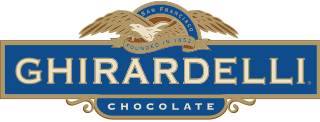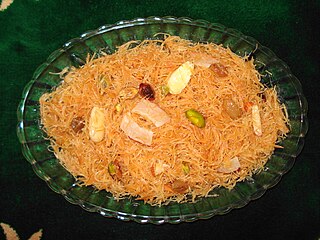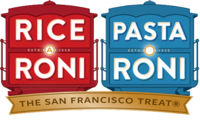
Macaroni is pasta shaped like narrow tubes. Made with durum wheat, macaroni is commonly cut in short lengths; curved macaroni may be referred to as elbow macaroni. Some home machines can make macaroni shapes but, like most pasta, macaroni is usually made commercially by large-scale extrusion. The curved shape is created by different speeds of extrusion on opposite sides of the pasta tube as it comes out of the machine.

Pasta is a type of food typically made from an unleavened dough of wheat flour mixed with water or eggs, and formed into sheets or other shapes, then cooked by boiling or baking. Unlike noodles, pasta was traditionally only made with durum, although the definition has been expanded to include alternatives for a gluten-free diet such as rice flour, or legumes such as beans or lentils. While noodles are believed to have originated in Asia, pasta is believed to have originated in Italy and is a staple food of Italian cuisine, with evidence of Etruscans making pasta as early as 400 BCE in Italy.

Spaghetti is a long, thin, solid, cylindrical pasta. It is a staple food of traditional Italian cuisine. Like other pasta, spaghetti is made of milled wheat, water, and sometimes enriched with vitamins and minerals. Italian spaghetti is typically made from durum-wheat semolina. Usually the pasta is white because refined flour is used, but whole wheat flour may be added. Spaghettoni is a thicker form of spaghetti, while spaghettini is a thinner form. Capellini is a very thin spaghetti, sometimes known colloquially as "angel hair pasta", while Vermicelli refers to intermediate widths, varying between the United States and Italy.

Breakfast cereal is a breakfast food made from processed cereal grains. It is traditionally eaten as part of breakfast, or a snack food, primarily in Western societies.

KD in Canada, Kraft Mac & Cheese in the United States, Australia and New Zealand, Mac and Cheese in the United Kingdom and internationally, is a nonperishable, packaged macaroni and cheese product. It is made by Kraft Foods Group and traditionally cardboard-boxed with dried macaroni pasta and a packet of processed cheese powder. It was introduced under the Kraft Dinner name simultaneously in both Canada and the U.S. in 1937. The brand is particularly popular with Canadians, who consume 55% more boxes per capita than Americans.

Vermicelli is a traditional type of pasta round in section similar to spaghetti. In English-speaking regions it is usually thinner than spaghetti, while in Italy it is thicker.

The Ghirardelli Chocolate Company is an American confectioner, wholly owned by Swiss confectioner Lindt & Sprüngli. The company was founded by and is named after Italian chocolatier Domenico Ghirardelli, who, after working in South America, moved to California. The Ghirardelli Chocolate Company was incorporated in 1852, and is the third-oldest chocolate company in the US, after Baker's Chocolate and Whitman's.

Pilaf, pilav or pilau is a rice dish, or in some regions, a wheat dish, whose recipe usually involves cooking in stock or broth, adding spices, and other ingredients such as vegetables or meat, and employing some technique for achieving cooked grains that do not adhere to each other.

Orzo, also known as risoni, is a form of short-cut pasta shaped like a large grain of rice. Orzo is traditionally made from flour, but it can also be made of whole grain. It is often made with semolina, a type of flour made from durum wheat.

Rice vermicelli is a thin form of noodle. It is sometimes referred to as "rice noodles" or "rice sticks", but should not be confused with cellophane noodles, a different Asian type of vermicelli made from mung bean starch or rice starch rather than rice grains themselves.

Tatar cuisine is primarily the cuisine of the Volga Tatars, who live in Tatarstan, Russia, and surrounding areas.

Sevai, shavige, saemia and santhakai is a type of rice vermicelli dish popular in India. While typically made from rice, varieties made out of other food grains like wheat, ragi, and others can also be found.

Vincent Michael "Vince" DeDomenico, Sr. was an American entrepreneur, one of the inventors of Rice-A-Roni, and a founder of the Napa Valley Wine Train.

Ebro Foods, S.A., formerly Ebro Puleva, is a Spanish food processing company. Ebro Foods is the world's largest producer of rice and the second biggest producer of pasta. The company's head office is in Madrid.
Pailadzou A. Captanian or Gaptanian was an Armenian-American survivor of the Armenian genocide, memoirist, and poet. She is also credited with inspiring the creation of Rice-A-Roni which is based on her own recipe of Armenian pilaf.

The Quaker Oats Company, known as Quaker, is an American food conglomerate based in Chicago, Illinois. As Quaker Mill Company, the company was founded in 1877 in Ravenna, Ohio. In 1881, Henry Crowell bought the company and launched a national advertising campaign for Quaker Oats.

Arabic rice or rice with vermicelli is a traditional preparation of rice in the Middle East, a variant of the simpler cooked rice recipe, but adding lightly toasted vermicelli. The rice cooking method is known as pilaf, by which the rice is fluffy, light and does not stick. Traditionally, a long-grain rice, such as basmati or jasmine, is used, although short-grain rice, such as bomba or misri ("Egyptian"), can be used perfectly. Brown rice can also be used.

















